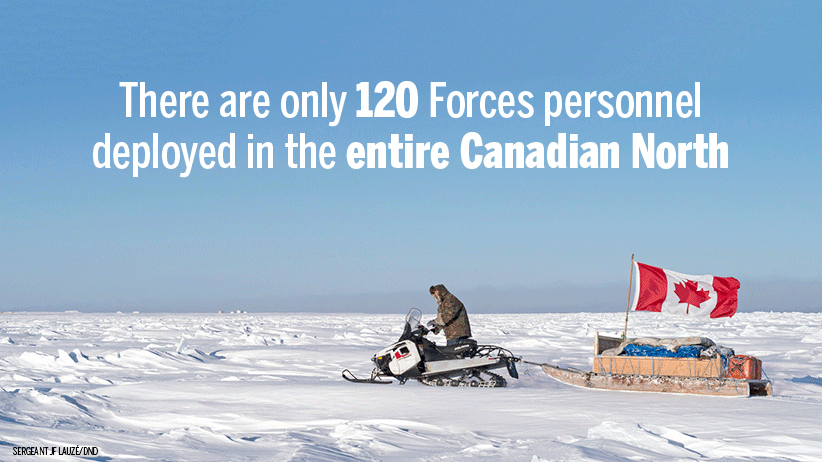The Canadian North is the least defended territory on earth
Never mind the Amazon, or even the Antarctic. Northern Canada is the global epitome of undefended territory.
Ice floes float in Baffin Bay above the Arctic circle from the Canadian Coast Guard icebreaker Louis S. St-Laurent on July 10, 2008. Research suggests that last year’s record loss of Arctic sea ice is already causing big changes that scientists are just starting to understand for plants and animals.THE CANADIAN PRESS/Jonathan Hayward
Share

There is no place on earth as poorly defended as the Canadian Arctic. But maybe that’s a good thing. We do enjoy pretending to be a nation of “peacekeepers” (in spite of the fact we currently do less peacekeeping than say, El Salvador or Gambia). Vimy Ridge, Juno Beach, Kapyong, Panjwaii: these are places typically not mentioned in polite company, and almost never spoken aloud by a Liberal government. When we talk about arming our military, we don’t even like to use the word “arm”—we say “procurement.”
So, perhaps it is fitting that the Canadian North is essentially the largest military-free zone in the world. To be fair, it is not utterly bereft of Canadian Forces. We have three very small bases. There are some radar installations (that use 1980s technology). There are the Rangers, of course, local volunteers who are given Second World War rifles, a hoodie, a ball cap and an annual photo op with whichever politician is shameless enough to fly north for 24 hours to emote about the Canadian North from the depths of his or her $1,200 Canada Goose parka. Our largest icebreaker— built in 1969—is currently undergoing it’s seventh refit. And, we have approximately 120 armed forces personnel, just enough to fill a Tim Hortons. All of this, of course, is spread over an area the size of Europe (except the icebreaker—it’s in Halifax).
The list of what we don’t have is considerably longer. There is no port, military or civilian. The closing of Churchill last year ended the fatuous notion that Canada has a third coast. No airbase. No search-and-rescue hub. No four-season ice-breakers. No ice-strengthened war-ships. In fact, our fleet is now so small and so rusted out it has lost the designation of being a “blue-water navy”, it is a coastal defence force—on calm days—if everything is working.
If you ask around Ottawa why this is, the answer is and always has been, “Because it’s hard.” Which is true. The Canadian North is remote, wild, undeveloped, like the Russian North for example. Facing a similar climate and geography, Moscow has only managed to build two infantry bases; nine naval ports; and seventeen airbases along its Arctic coast over the last 60 years.
But the Canadian Arctic is more remote and difficult to access than Russia’s. It is more like the Amazonian rainforest—an expanse of jungle and swamp 25 per cent larger than the Canadian North. The Brazilians have almost nothing there, other than the Manaus Air Base, home to four air squadrons, and an airborne army battalion. And there are several naval facilities, including the Rio Negro naval base, 1,300km up the Amazonian river. That base has nine satellite facilities, as well as a helicopter squad and marines. The Brazilians also have a fleet of large riverine hospital ships that ply the remote backwoods of the jungle. But that’s it.
But the Brazilians spend 2.6 per cent of their GDP on the military. The economic choices of our political leaders have always been less guns and more butter (supply-managed, thank you). Regardless of our formal obligations to NATO that we spend two per cent on the Canadian Forces, our defence budget comes in at half that.
We have much more in common with Australia, a commonwealth democracy, managing a constant political struggle to maintain social services and infrastructure spending. It makes sense that we would be careful about our military deployments, frugal even. Consider how the Australian’s have chosen to defend the Outback. Other than a huge naval base in Darwin, and several air squadrons at the RAAF Tindal, another couple of air bases, a dozen training bases, an infantry battalion, and large radar installations at Alice Springs and elsewhere, the place is empty.
Even in Antarctica, at the bottom of the world, owned by no country, needing no defence, and subject to a treaty prohibiting military activity, there are dozens of research bases run by the armed forces of countries like Chile, Uruguay and even Pakistan. The search and rescue capabilities of McMurdo Station alone are greater than all of Canada’s north of the 60th parallel.
No, if you want to get away from it all, to go somewhere on the planet where no one will be able to rescue you—or stop you, or even know you’re there—you want Canada’s North.
But try to keep this quiet. We don’t want it overrun by adventure tourists. Or cruise ships like the Crystal Serenity, which went through last summer bringing its own rescue ship because Canada didn’t have one. Or resource companies, now free to roam over ice-free waters. Or the Chinese, who want to start sending cargo ships and oil tankers through on their way to Europe. Or the Russians, who are increasingly overflying NATO territory. Or our American allies, who announced in Congress this week they will not recognize Canada’s sovereignty over the Northwest Passage.
No, let’s follow the leadership of Prime Minister Trudeau, who made sure the Arctic was only mentioned twice in the 360 priorities he gave his ministers, and who has bravely avoided drawing any attention to the North—visiting only once since taking office—and who has still not published an Arctic strategy. Let’s just not draw any attention to the fact we’ve utterly abandoned the Canadian North. What could possibly go wrong?